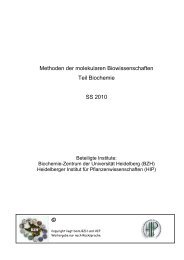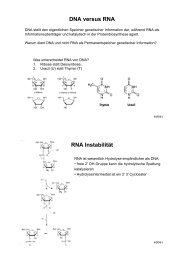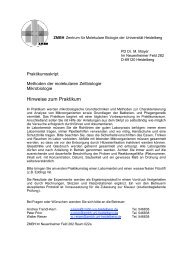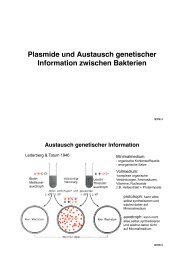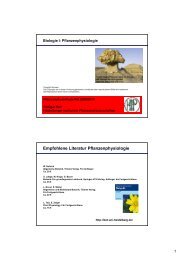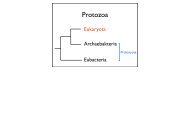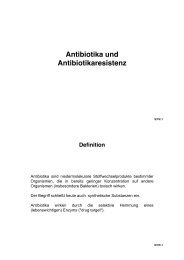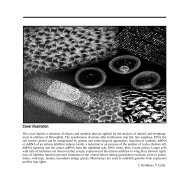ZMBH J.Bericht 2000 - Zentrum für Molekulare Biologie der ...
ZMBH J.Bericht 2000 - Zentrum für Molekulare Biologie der ...
ZMBH J.Bericht 2000 - Zentrum für Molekulare Biologie der ...
Create successful ePaper yourself
Turn your PDF publications into a flip-book with our unique Google optimized e-Paper software.
Figure 2: Monitoring<br />
gene activation and<br />
inactivation in live animals.<br />
Mice double transgenic<br />
for tTA and the<br />
luciferase gene un<strong>der</strong><br />
Ptet control are injected<br />
with luciferin and anesthesized<br />
for 5 min.<br />
before they are placed<br />
into the Hamamatsu<br />
photon counting device<br />
Argus 20 (left upper part<br />
of fig.). Photons emitted<br />
by luciferase active in<br />
liver (left most animal)<br />
and in brain (right<br />
animal) are collected as<br />
imaged below. The single<br />
transgenic animal in the<br />
middle serves as control.<br />
Feeding Dox to the<br />
“liver mouse” abolishes<br />
luciferase activity within<br />
5 days. Removal of Dox<br />
in the drinking water reestablishes<br />
luciferase activity within 5 days (“brain mouse” as control). The cycle of switching was repeated with the same<br />
animals after 3 months with identical results, except that 2 days of exposure to Dox were sufficient to shut off luciferase activity<br />
in the liver. The luciferase gene is driven by a bidirectional Ptet which coregulates the Cre recombinase gene. Luciferase<br />
activity correlates with Cre activity. Whole body images of the animals are shown.<br />
II The Merozoite Surface Protein 1 of<br />
the Human Malaria Parasite Plasmodium<br />
falciparum<br />
Malaria is one of the most widely spread infectious<br />
diseases with around 40 % of the world‘s population<br />
living in areas at risk. The hope for an effective vaccine<br />
candidate against infection of P.falciparum, the<br />
most lethal one among the human malaria parasites,<br />
relies on the subunit concept where individual components<br />
of the parasite are utilized to elicit a protective<br />
immune response. Our studies focus on a 190 kDa<br />
protein which is the major surface protein of the mero-<br />
50<br />
zoite (MSP-1), one of the parasite‘s blood forms. This<br />
protein is believed to play a role during invasion of<br />
erythrocytes by the parasite. It is a target of the human<br />
immune response at the humoral as well as at the cellular<br />
level. Such findings suggest that MSP-1 may<br />
elicit a protective immune response when used as a<br />
vaccine in humans. The aim of our work is to develop<br />
an experimental vaccine that is suitable for human<br />
trials. Moreover, we are interested in the function of<br />
MSP-1 and its structure at the parasite‘s surface.<br />
Synthetic msp-1 genes provide material for<br />
immunological, structural and functional studies<br />
C. Epp, C. Fernandez-Becerra, C. Schmid, I. Türbachova,<br />
N. Westerfeld<br />
P.falciparum DNA has an exceptionally high AT content<br />
which amounts to 76 % in the coding area of<br />
MSP-1. The high AT content has prevented the stable<br />
cloning of large genes of this parasite and thus severely<br />
hampered their study. We have synthesized the genes<br />
of both MSP-1 prototypes (together around 10 000<br />
bp) based on human codon frequencies and are now in<br />
a position to produce MSP-1 and <strong>der</strong>ivatives thereof<br />
in various heterologous systems. During maturation<br />
of merozoites, MSP-1 un<strong>der</strong>goes proteolytic cleavage<br />
resulting in five major fragments that can be isolated<br />
as one complex from the merozoite surface. The proteolytic<br />
cleavage sites were reconciled in the design of<br />
our synthetic genes, and accordingly expression vehicles<br />
encoding the various fragments are available as<br />
well. Efficient expression of the intact genes as well<br />
as of DNA encoding the processing products has been<br />
achieved in E.coli. Full size MSP-1 is also produced<br />
and secreted into the medium by bacterial L-forms<br />
(collaboration with M. Kujau, IMB, Jena) from where<br />
it can be isolated in soluble form. We now concentrate<br />
on devicing a production procedure for MSP-1<br />
that is suitable for „good manufacturing practice“.<br />
Our highly purified preparations will also be used<br />
for structural studies and for exploring interactions<br />
between the individual processed domains as well as<br />
between MSP-1 and the erythrocyte surface. A second<br />
focus of this project is the integration of msp-1 into<br />
viral systems that are suitable as vaccine carriers in<br />
humans, such as vaccinia and measles viruses.<br />
A MSP-1 based ELISA for sero-epidemiological<br />
surveys<br />
C. Epp, I. Idler, I. Türbachova, S. Weerasuriya<br />
The availability of the various MSP-1 processing products<br />
in apparently native conformation has enabled us<br />
to develop an ELISA that can be used for serum analysis.<br />
In a first approach, we have examined the sera<br />
from two trials in which Aotus monkeys were immunized<br />
with MSP-1 and challenged with merozoites<br />
(collaboration with S. Herrera, Cali, Colombia). Full<br />
protection was achieved in 60 % of the animals. Interestingly,<br />
protection correlated well with the humoral<br />
response against certain areas of MSP-1. Using the<br />
new ELISA, we are now re-examining the sera collected<br />
during our earlier epidemiological studies in<br />
West Africa. Our previous analysis has indicated a<br />
correlation between antibody titers towards certain<br />
regions of MSP-1 and a reduced risk of reinfection<br />
by P.falciparum.We hope that our new analysis will<br />
reveal more clearly which regions of MSP-1 may be<br />
involved in eliciting a protective humoral response.<br />
The ELISA may eventually permit the development of<br />
a diagnostic tool with predictive properties.<br />
Attempts to identify interactions between<br />
MSP-1 and the surface of erythrocytes<br />
P. Burghaus, I. Türbachova<br />
As the major protein at the surface of merozoites,<br />
MSP-1 has been implicated in early association events<br />
during the erythrocyte invasion. Following the successful<br />
strategy described for the Duffy binding protein,<br />
we have exposed full length MSP-1 as well as<br />
stepwise truncated versions of the protein on the surface<br />
of HeLa cells, fixed, as in the parasite, by a<br />
51



